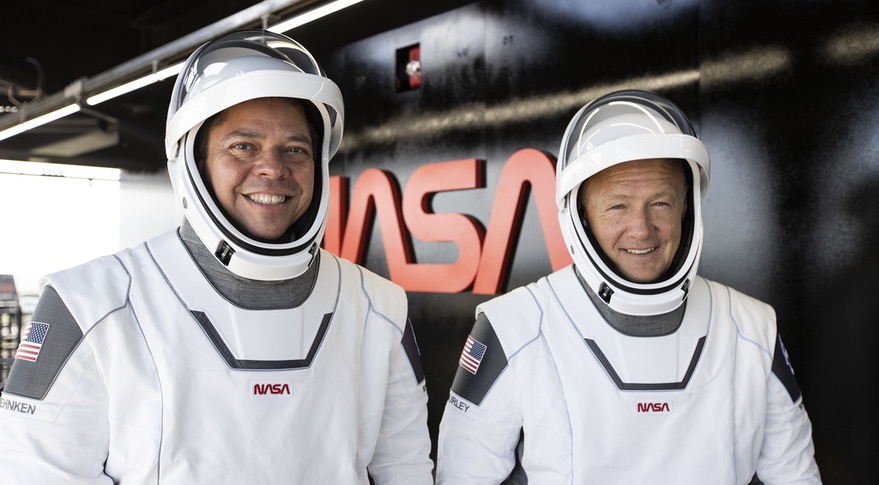
Commercial crew astronauts accept risks of test flight
by Jeff FoustWASHINGTON — The astronauts who will fly the first Crew Dragon mission say they understand and accept the risks of a new spacecraft, which they believe can’t be boiled down to a single number.
NASA’s commercial crew program set a number of safety requirements for the spacecraft whose development it supported. Among them was a “loss-of-crew” figure of merit — a measure of the probability of death or permanent disability of one or more people on a spacecraft during a mission — of 1 in 270.
Achieving that requirement proved difficult for both Boeing and SpaceX, a point raised in a number of meetings of the agency’s Aerospace Safety Advisory Panel. “The number one safety-related concern for the program is the current situation with respect to the estimate of loss of crew,” Donald McErlean said at a 2017 meeting of the panel.
Both NASA and the two companies said since then that they have made progress on vehicle improvements and other “operational mitigations” to meet the 1-in-270 requirement, which the agency confirmed at a May 22 briefing after the flight readiness review for the Demo-2 mission.
“Between SpaceX and the operational controls, we are meeting our 1-in-270 requirement,” Kathy Lueders, NASA commercial crew program manager, said at the briefing. That included work with SpaceX on the modeling and design of the spacecraft, with a particular emphasis on mitigating the risks of damage from micrometeoroids and orbital debris impacts.
Meeting that requirement does not mean the spacecraft is free of risks. “A big part of a flight readiness review is reviewing and accepting the risks,” Steve Jurczyk, NASA associate administrator, said at that May 22 briefing. “Whenever we fly, there are going to be residual risks.”
Bob Behnken and Doug Hurley, the astronauts who will fly on the Demo-2 mission, said they were aware of, and accepted, the risks. “Whenever we hear those numbers, we dig a little bit deeper than just what the overall statistics might imply,” Behnken said in a May 22 media availability, referring to the 1-in-270 loss-of-crew requirement.
The two astronauts, who each flew on two shuttle missions, have been involved in the commercial crew program since 2015, when NASA selected them as part of an initial “cadre” of astronauts who would train and work with both Boeing and SpaceX on their commercial crew vehicles. NASA formally assigned Behnken and Hurley to the Demo-2 mission in August 2018.
“We’ve had the luxury over the last five-plus years to be deeply embedded and understand the trades that were made,” he said. “I think we’re really comfortable with it and we think that those trades have been made appropriately. As far as insight goes, we’ve probably had more than any crew has in recent history.”
Hurley agreed. “Those numbers are certainly part of the equation when you assess risk, but they’re certainly not exclusive by any stretch of the imagination,” he said of the loss-of-crew requirement. “They’re certainly a factor, but there’s just so much more to assessing risk, and all the things that you put into the decision matrix before you go fly.”
Crew Dragon is the first crewed American orbital spacecraft to fly since the space shuttle Columbia’s first flight in 1981, and just the ninth such spacecraft worldwide in history, when including Mercury, Gemini and Apollo in the U.S.; Vostok, Voskhod and Soyuz in the former Soviet Union and China’s Shenzhou.
NASA has emphasized the superior safety of Crew Dragon, and Boeing’s CST-100 Starliner, over the shuttle. While the commercial crew vehicles have to meet a 1-in-270 loss-of-crew metric, the shuttle has a loss-of-crew estimate of 1 in 90 when it was retired in 2011.
In a 2017 speech at the annual Commercial Space Transportation Conference, Bill Gerstenmaier, then NASA associate administrator for human exploration and operations, said that early shuttle flights were far riskier: about 1 in 12, compared to models at the time that offered loss-of-crew estimates between 1 in 500 and 1 in 5,000.
Like the astronauts, Gerstenmaier said the single loss-of-crew estimate was along not sufficient, and could even be gamed through design changes that improved the risk figure but introduce additional complexity.
“I really don’t have a better method than that to use this as an absolute measure of safety,” he said. “We just need to be careful when we discuss these numbers.”